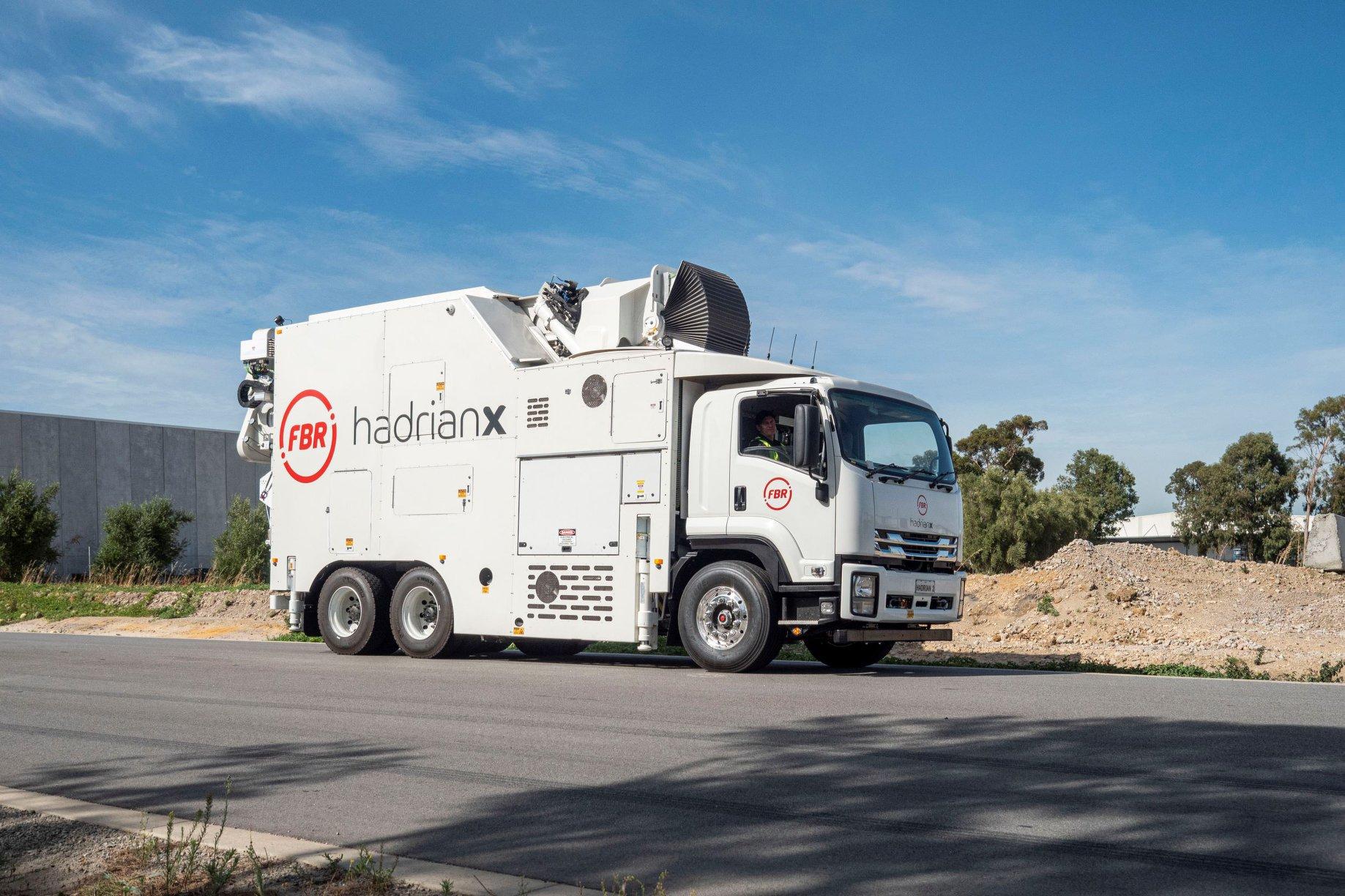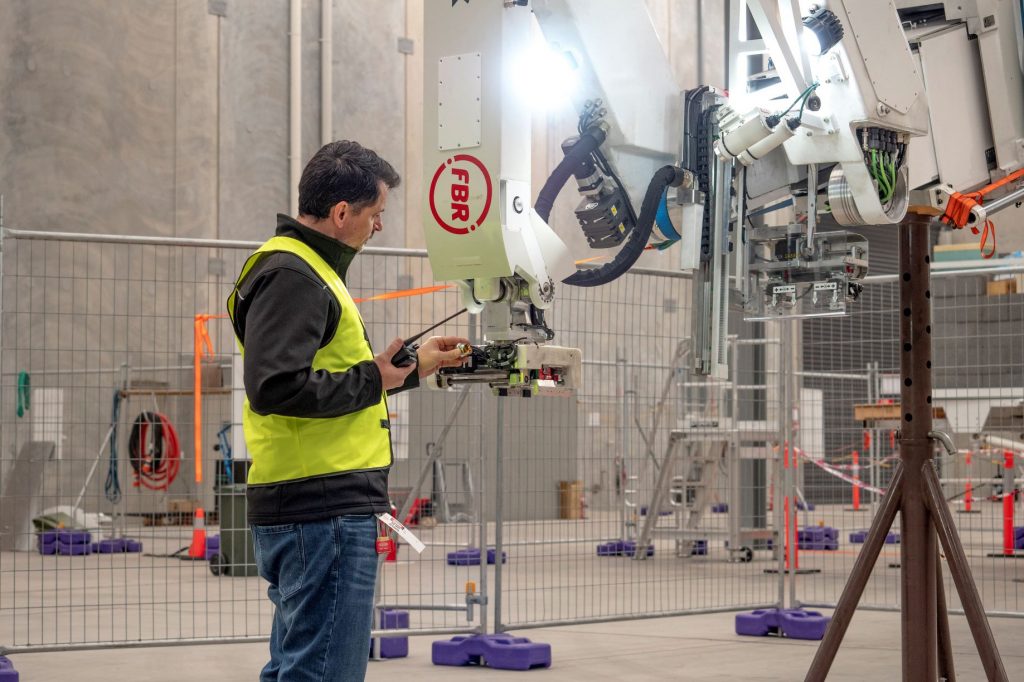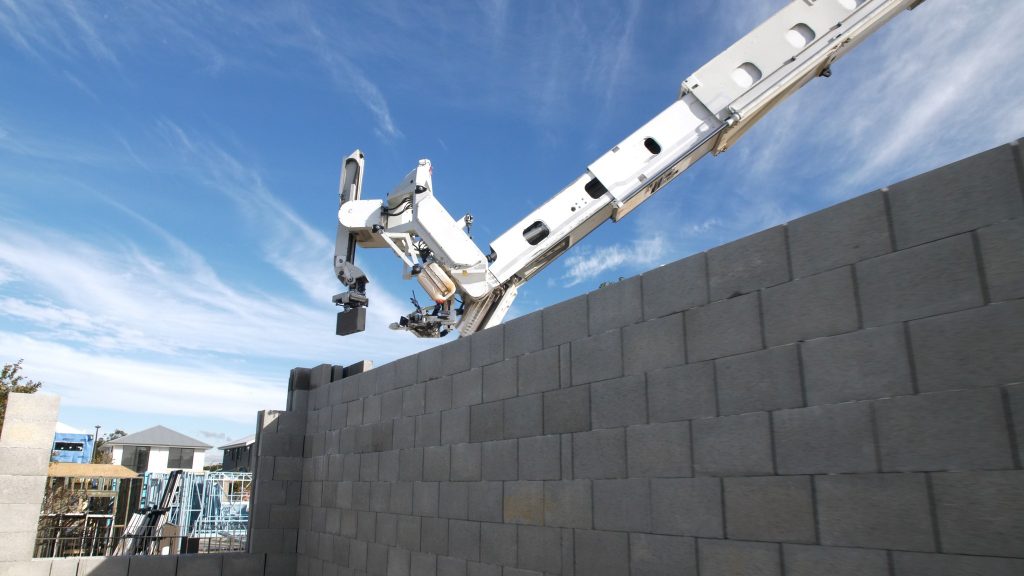
How Hadrian X, The Bricklaying Robot, Is Advancing Construction Automation
Jerry Wallis
12 min read

Recently, a growing interest has been in using robotics for construction automation. One such breakthrough is Hadrian X, a revolutionary bricklaying robotics technology developed by the Australian company Fastbrick Robotics (FBR).
The robot’s bricklaying technology uses a combination of 3D scanning, dynamic stabilisation, computer-aided design, and robotics to quickly and efficiently build structures.
One of the key challenges in building structures using a robot like Hadrian X is ensuring that the robot remains stable and balanced while it moves and operates. This is where dynamic stabilisation technology comes in.
In this case study, we will explore the versatility and potential of Hadrian X as a legitimate construction alternative. We will also examine the various components of the robot’s dynamic stabilisation system, how it works, and the benefits it provides.
What Is Hadrian X & How Did It Come To Be? 👷

Hadrian X is a pioneering and fully autonomous bricklaying robot developed by the Australian company FBR Limited. It is designed to build houses and other structures quickly and efficiently using automated construction. The robot is specifically developed as a smarter construction alternative for bricklaying and uses an innovative approach to building walls that is faster and more efficient than traditional or manual bricklaying methods.
🧱 The Need For Construction Robotics In Bricklaying
Bricklaying has long been recognised as a tedious and laborious trade that ultimately takes a toll on the human body. Mason workers often develop shoulder, arm, and wrist tendonitis due to overuse and repetitive motion and essentially trade their bodies for a paycheck.
While the bricks themselves have become more standardised in shape, size, and composition, the art of laying them has remained the same across centuries gone by. That said, the inefficiencies of manual bricklaying have been acknowledged for decades, yet there hasn’t been much innovation in this field to automate the process and relieve humans until Hadrian X entered the fray.
Moreover, the evolution of construction automation in bricklaying should enable bricklayers to transition from laborious and unsafe trades to being machine operators and site quality supervisors, providing a more physically sustainable career path.
🏘️ What Can Hadrian X Do?
It is estimated that the bricklaying robot can build a traditional three-bedroom, two-bathroom house in a matter of days, depending on the type of block used and the complexity of the structure. Dubbed by many as the world’s most advanced construction robot, if it’s placed in the right environment and allowed to work uninterrupted, each unit could build anywhere between 100 to 300 homes annually. By any standards, that is seriously impressive!
When working correctly, Hadrian X can place about one block every 20-30 seconds, equating to more than 180 standard bricks per hour. In comparison, a human bricklayer, under perfect settings with a coordinated team of labourers, can lay around 80 to 120 bricks an hour. FBR aims to improve the Hadrian’s productivity to over 1000 bricks per hour.
Moreover, despite an impressive record of building a standard-sized home every two days on average, this remarkable robot has an astonishingly small footprint. This allows it to be mounted onto a classic cab over-engine truck and easily transported to and from a construction site.
The versatility of Hadrian X doesn’t end there. This construction robot can also be mounted onto other vehicle bases, such as barges, boats, and cranes, making it a flexible construction utility for different types of buildings and locations.
⌛ History Of Hadrian X
The development of the bricklaying robot began in 1994, when the company’s founder, Mark Pivac, began exploring the idea of using dynamically stabilising robots to automate the construction industry.
In 2005, Mark went forward towards creating the first iteration of the Hadrian prototype after filing a patent application for an automated bricklaying system. The company then began testing and refining the technology to develop a commercial product that could be used in the construction industry.
After a temporary stoppage during the early 2010s, FBR resumed working on Hadrian until they finally reached Hadrian 105, the precursor to Hadrian X.
In 2018, Fastbrick Robotics unveiled Hadrian X, a fully functional bricklaying robot capable of laying bricks with minimal manual intervention. The robot was designed for various construction environments, including residential and commercial building sites.
Since its introduction, the robot has undergone several updates and improvements. In 2019, the company announced that it had completed the first outdoor home structure using it. Later, in 2020, it achieved a significant performance milestone with a commercial bricklaying rate of over 200 bricks per hour.
Today, Hadrian X is considered one of the most advanced bricklaying robots in the world, and it has the potential to revolutionise the construction industry by dramatically reducing the time and cost of building structures.
The technology behind Hadrian X is constantly evolving, and we will likely see further advances and improvements in the years to come. In fact, plans are already underway in FBR to build the next generation of Hadrian robots. In the next 12 months, FBR plans to launch Hadrian to the international market and establish partner entities in the US and Europe. They are also testing roofing robotics with a new shuttle architecture of the next-gen Hadrian.
Hadrian X’s Proprietary Software: Dynamic Stabilisation Technology (DST) ⚖️
Hadrian X uses a proprietary optimisation software called Dynamic Stabilisation Technology (DST)™ to automate and optimise the bricklaying process.
DST is the underlying technology enabling Hadrian X to showcase its true potential. DST measures the real-time movement caused by wind, vibration, and inertia. This intelligent robot then responds instantaneously using advanced algorithms to offset the external movement to maintain stability and offer unparalleled precision in a variety of conditions.
Essentially, FBR’s Dynamic Stabilisation Technology allows the robot to operate efficiently outdoors in the construction environment. DST corrects for dynamic interference and vibration in the boom and layhead caused environmental factors, machinery movement, and thermal changes in real-time and precisely places blocks.
DST is designed to optimise the placement of each brick, taking into account factors such as the location of the last brick, the position of the robotic arm, and the orientation of the brick. The software uses advanced algorithms to analyse these factors and determine each brick’s optimal position and orientation.
One key feature of DST is its ability to adapt to changes in the building environment. For example, the software can detect and adjust for variations in the brick size, shape, and colour, as well as changes in the alignment of the building structure.
The DST software also incorporates machine learning capabilities to improve its performance over time. As the system lays more bricks, it can learn from its mistakes and refine its algorithms to make more accurate and efficient brick placements over time.
All in all, the FBR’s DST is the crucial component of the robot’s system, allowing it to automate and optimise the bricklaying process in a faster, more accurate, stable, and more efficient way than traditional manual methods.
Other Notable Technologies Behind The Bricklaying Robot 👨💻
Hadrian X make robotic construction a reality. The technology behind this mechanism involves an intuitive combination of 3D scanning, computer-aided design (CAD), and robotics powered by proprietary optimisation software.
🤖 Precision Construction Robotics
Being the world’s first mobile robotic block-laying system, Hadrian X is fully capable of operating in uncontrolled construction environments swiftly and efficiently. Hadrian X uses 3D CAD models to build block structures that produce far less waste than traditional construction methods, dramatically improving site safety. In addition, its efficiency in building a house’s walls is impressive, as it can complete the endeavour in as little as a day.
Hadrian X’s precision construction robotics technology allows it to lay bricks with an accuracy of up to 0.5 millimetres. This level of precision ensures that the walls are constructed to exact specifications and that there are no gaps or errors in the construction process. It also measures wind, vibration and other interference in real-time, which helps to ensure and maintain the accuracy of block placement at all times.
🧠 Intelligent Control System
Hadrian X uses a unique proprietary optimisation software that converts wall sketches into block positions and minimises handling and waste of block products to improve the efficiency of residential construction.

🚧 Fastbrick Wall System
FBR’s Fastbrick Wall System™ is essentially the combination of Hadrian-optimised blocks and adhesive, together with a cladding material like acrylic render. Hadrian X uses modular blocks with aligned cores to ensure easy cabling installation and services through the cavities.
So, How Does Hadrian X Actually Work? ⚙️
Hadrian X begins by scanning the site where the structure will be built. Next, it uses LiDAR (Light Detection and Ranging) technology to create a 3D map of the site, which is then used to create a CAD model of the building.
Once the site has been scanned, the CAD model is created by considering the building’s design and structural requirements. The CAD model is then fed into the robot’s control system.
Then, pallets of blocks cut using an internal saw are loaded into the robot and unpacked by several dehacker robots. Finally, the blocks are transferred using a telescopic boom, applied with adhesive, and placed precisely in the correct position. Now, you might think, what about the mortar?
That’s one of the great things about Hadrian X. It doesn’t require a traditional mortar as it uses an advanced construction adhesive that cures in 45 mins and is comparatively much more robust.
Off-cuts are used later in the build to minimise waste and enforce environmental sustainability. The DST technology allows the robot to place blocks precisely over a distance regardless of environmental factors causing stabilisation obstruction.
How Does Hadrian X Change Construction As We Know It? 🏗️
There are several advantages of Hadrian X that make this construction robot a definite mainstay for now and the future. Let’s explore them in further detail below:
- Speed & Efficiency: Hadrian X can lay bricks at a rate of up to 1,000 bricks per hour, which is significantly faster than traditional bricklaying methods. This can help to reduce construction time and costs. For instance, it can lay down the blockwork for a standard 3-bed, 2-bath house in under two days!
- Accuracy & Precision: It uses 3D scanning and computer-aided design to ensure that bricks are laid with a high level of accuracy and precision, which can help improve the quality of the built structure.
- Safety: By using a robot to lay bricks, construction workers can avoid some of the risks associated with traditional bricklaying methods, such as repetitive strain injuries or falls from height.
- Flexibility: It can be used to build various brick and block structures and work in multiple construction environments, including residential and commercial building sites.
- Sustainability: It can help reduce waste and increase the efficiency of the construction process, which can have environmental benefits.
- Faster Time To Market: As it generates a super-accurate 3D CAD model of the construction, a precise bill of materials can be generated before bricklaying begins. This allows building materials to be prepared off-site and readied to be installed immediately upon completion of the brickwork project. Ultimately, customers can move into their new homes much sooner than they usually would.
- Overcome Labour Shortage: Being a fully automated construction equipment, Hadrian X requires minimal human operation to perform its tasks. Therefore, this technology has the potential to solve a major industry crisis and also lower housing costs at the same time.

The Disadvantages of Hadrian X ⛔
While the benefits of the bricklaying robot are seriously impressive and difficult to overlook, we also have to consider some of its shortcomings.
- Initial Upfront Costs: Hadrian X is estimated to cost AUD $2 million per unit. This is a sizeable investment that will surely deter a lot of construction companies, especially smaller-mid-sized builders.
- Singular Functionality: While it can lay bricks and do so very well, it has limited functionality. It can only perform a single task, which is to lay bricks, and it cannot execute other construction trades such as plumbing, electrical work, or painting. This means that other workers will still be needed on a construction site to perform these tasks, which can increase overall costs.
- Job Displacement: Yes, it works both ways. While it can be a boon during a labour shortage, it can also be the reason for labourers to lose their jobs. The use of automation technology in construction can lead to job displacement, as fewer workers will be needed to perform certain tasks like bricklaying.
- Dependence On Technology: The use of automation technology in construction also comes with the risk of reliance on technology. If the robot breaks down or malfunctions, construction may come to a halt until the problem is resolved. This can cause delays and increase costs, especially if there is a shortage of skilled technicians who can repair the robot.
- Lack Of Flexibility: Hadrian X bricklaying robot is designed to work on a specific type of project and may only be suitable for some types of construction. Additionally, the robot may not be able to work in tight spaces or on complex structures, which can also limit its functionality. For instance, it cannot build bricks around windows and door openings.
The Future Of Construction Is Now! 🔮
In conclusion, Hadrian X, the bricklaying robot developed by FBR, uses dynamic stabilisation technology for construction automation. By combining 3D scanning, computer-aided design, and robotics, Hadrian X can lay bricks quickly, accurately, and safely. The dynamic stabilisation technology ensures that the robot remains stable and balanced while it moves and operates, which is essential for its success in the construction industry.
Hadrian X has the potential to revolutionise the construction industry by reducing construction time and costs, improving the quality of structures built, and increasing sustainability. As the technology behind Hadrian X continues to develop, the robot will become even more effective and efficient in the construction industry.
We can learn a lot from innovative technology, such as Hadrian X and how it can help shape the future of an entire industry. Would you like to learn more about such technologies or build something like this yourself? If you’re interested in jumping aboard the technology train, book a discovery chat with us. Our solutions experts will be more than happy to guide you through the process and answer any questions.
Topics
Published On
February 24, 2023

